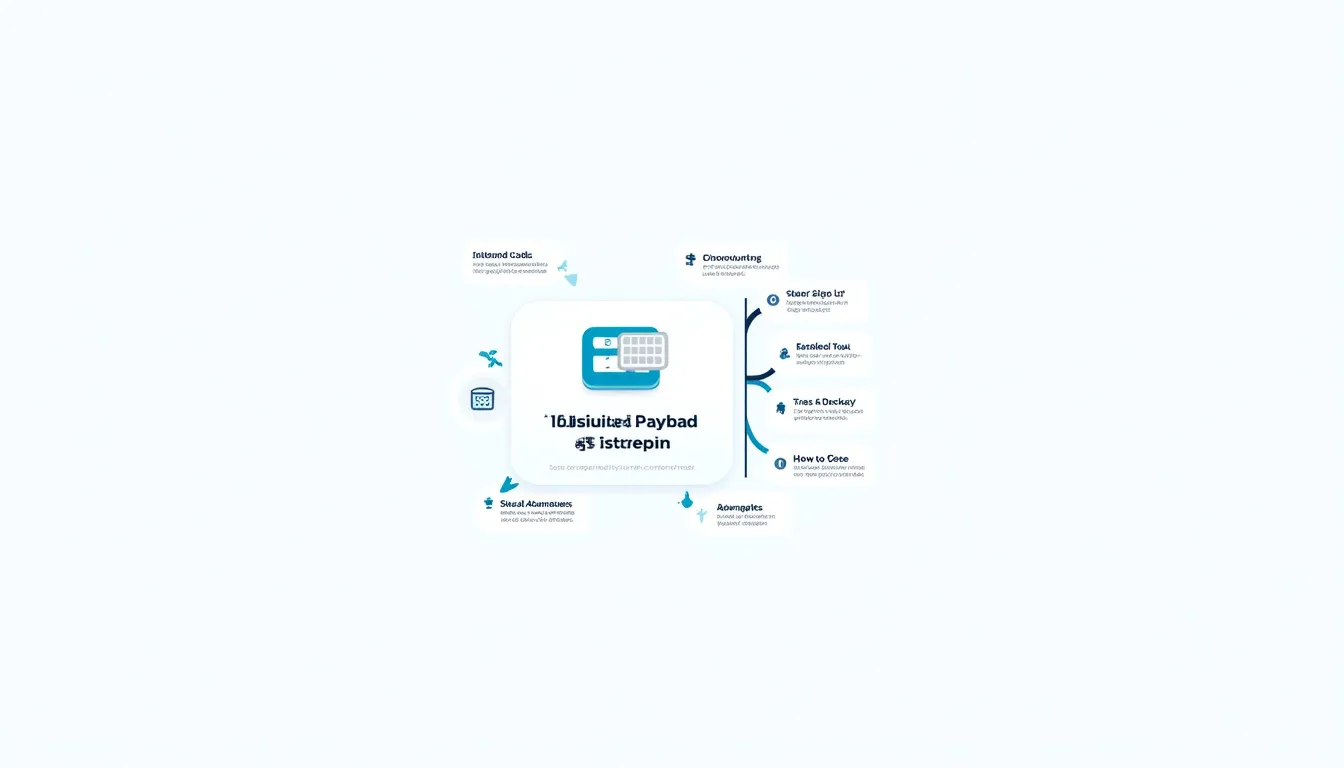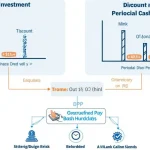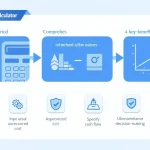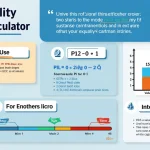Discounted Payback Period Calculator
Is this tool helpful?
How to Use the Discounted Payback Period Calculator Effectively
Our Discounted Payback Period Calculator is designed to help you make informed investment decisions by determining how long it will take for an investment to recoup its initial cost, considering the time value of money. Follow these steps to use the calculator effectively:
- Enter the Initial Investment (Outflow): Input the total upfront cost of your investment in USD.
- Specify the Rate: Enter the discount rate as a decimal (e.g., 0.05 for 5%). This rate represents the time value of money or the required rate of return.
- Input the Periodic Cash Flow: Enter the expected periodic cash inflow generated by the investment in USD.
- Calculate: Click the “Calculate” button to obtain the Discounted Payback Period.
- Interpret the Result: The calculator will display the Discounted Payback Period in years, helping you assess the investment’s viability.
Understanding the Discounted Payback Period: Definition, Purpose, and Benefits
The Discounted Payback Period is a financial metric used to evaluate the profitability and risk of an investment by calculating the time required to recover the initial investment, taking into account the time value of money. Unlike the simple payback period, which ignores the time value of money, the discounted payback period provides a more accurate assessment of an investment’s potential by considering the discount rate.
Purpose of the Discounted Payback Period
The primary purposes of calculating the Discounted Payback Period include:
- Assessing investment viability
- Comparing multiple investment opportunities
- Evaluating the risk associated with an investment
- Determining the time required to recover the initial investment
- Incorporating the time value of money into investment decisions
Benefits of Using the Discounted Payback Period
Utilizing the Discounted Payback Period in your investment analysis offers several advantages:
- Time Value of Money: It accounts for the fact that money received in the future is worth less than money received today.
- Risk Assessment: Helps in evaluating the risk associated with an investment by considering the time it takes to recover the initial outlay.
- Improved Decision-Making: Provides a more accurate picture of an investment’s profitability compared to the simple payback period.
- Project Comparison: Allows for easy comparison between different investment opportunities with varying cash flow patterns.
- Capital Budgeting: Assists in making informed capital budgeting decisions by considering the time value of money.
The Mathematical Formula Behind the Discounted Payback Period Calculator
The Discounted Payback Period is calculated using the following formula:
$$ DPP = \frac{\log\left(\frac{1}{1 – \frac{I \times r}{C}}\right)}{\log(1 + r)} $$Where:
- DPP = Discounted Payback Period
- I = Initial Investment (Outflow)
- r = Discount Rate
- C = Periodic Cash Flow
This formula takes into account the time value of money by discounting future cash flows to their present value, providing a more accurate assessment of when an investment will break even.
How the Discounted Payback Period Calculator Addresses User Needs
Our Discounted Payback Period Calculator is designed to address various user needs and solve specific problems in investment analysis:
1. Simplifying Complex Calculations
The calculator eliminates the need for manual calculations, which can be time-consuming and prone to errors. By automating the process, users can quickly obtain accurate results without the risk of mathematical mistakes.
2. Incorporating Time Value of Money
Unlike simple payback period calculations, this tool factors in the time value of money, providing a more realistic assessment of an investment’s profitability. This is particularly important for long-term investments where the impact of discounting is significant.
3. Facilitating Investment Comparisons
The calculator allows users to easily compare multiple investment opportunities by quickly determining their respective discounted payback periods. This enables more informed decision-making when choosing between different projects or investments.
4. Assessing Investment Risk
By providing the discounted payback period, the calculator helps users evaluate the risk associated with an investment. A shorter payback period generally indicates lower risk, as the initial investment is recovered more quickly.
5. Enhancing Capital Budgeting Decisions
For businesses and financial professionals, the calculator aids in making more informed capital budgeting decisions. It helps in prioritizing projects and allocating resources more effectively based on their discounted payback periods.
Practical Applications and Use Cases
The Discounted Payback Period Calculator has numerous practical applications across various industries and investment scenarios. Here are some examples to illustrate its utility:
1. Manufacturing Equipment Investment
A manufacturing company is considering purchasing new equipment for $500,000. The equipment is expected to generate annual cash flows of $100,000, and the company’s discount rate is 8%.
- Initial Investment (Outflow): $500,000
- Rate: 0.08 (8%)
- Periodic Cash Flow: $100,000
Using the calculator, we find that the Discounted Payback Period is approximately 6.73 years. This information helps the company decide whether the investment aligns with their financial goals and time horizons.
2. Real Estate Development Project
A real estate developer is evaluating a project with an initial investment of $10 million. The project is expected to generate annual cash flows of $1.5 million, and the developer’s discount rate is 10%.
- Initial Investment (Outflow): $10,000,000
- Rate: 0.10 (10%)
- Periodic Cash Flow: $1,500,000
The calculator reveals a Discounted Payback Period of approximately 9.57 years. This helps the developer assess whether the project’s timeline aligns with their investment strategy and risk tolerance.
3. Energy Efficiency Upgrade
A company is considering an energy efficiency upgrade costing $200,000. The upgrade is expected to save $50,000 annually in energy costs, and the company’s discount rate is 6%.
- Initial Investment (Outflow): $200,000
- Rate: 0.06 (6%)
- Periodic Cash Flow: $50,000
Using the calculator, we find that the Discounted Payback Period is approximately 4.54 years. This information helps the company determine if the energy efficiency upgrade is a worthwhile investment in terms of both financial returns and sustainability goals.
4. Technology Start-up Investment
An angel investor is considering investing $1 million in a technology start-up. The start-up projects annual cash flows of $300,000, and the investor’s required rate of return is 15%.
- Initial Investment (Outflow): $1,000,000
- Rate: 0.15 (15%)
- Periodic Cash Flow: $300,000
The calculator shows a Discounted Payback Period of approximately 4.82 years. This helps the investor assess the risk and potential return of the investment, considering their investment horizon and risk tolerance.
5. Marketing Campaign ROI
A company is planning a marketing campaign with an upfront cost of $500,000. The campaign is expected to generate additional revenue of $200,000 per year, and the company’s discount rate is 7%.
- Initial Investment (Outflow): $500,000
- Rate: 0.07 (7%)
- Periodic Cash Flow: $200,000
Using the calculator, we find that the Discounted Payback Period is approximately 2.86 years. This information helps the marketing team justify the campaign’s budget and set realistic expectations for its financial impact.
Frequently Asked Questions (FAQ)
1. What is the difference between Payback Period and Discounted Payback Period?
The Payback Period calculates how long it takes to recover the initial investment without considering the time value of money. The Discounted Payback Period, on the other hand, takes into account the time value of money by discounting future cash flows to their present value, providing a more accurate assessment of when an investment will break even.
2. How does the discount rate affect the Discounted Payback Period?
A higher discount rate will result in a longer Discounted Payback Period, as future cash flows are discounted more heavily. Conversely, a lower discount rate will lead to a shorter Discounted Payback Period.
3. What are the limitations of using the Discounted Payback Period?
While the Discounted Payback Period is a useful metric, it has some limitations:
- It doesn’t consider cash flows beyond the payback period
- It doesn’t account for the project’s overall profitability
- It may favor short-term projects over long-term investments
4. How do I choose the appropriate discount rate?
The discount rate should reflect your required rate of return or the cost of capital. It can be based on factors such as:
- The company’s weighted average cost of capital (WACC)
- The risk-free rate plus a risk premium
- The opportunity cost of investing in alternative projects
5. Can the Discounted Payback Period be negative?
No, the Discounted Payback Period cannot be negative. If the calculator returns a negative value, it indicates that the investment will never recover its initial cost based on the given inputs.
6. How does the Discounted Payback Period compare to other investment metrics?
The Discounted Payback Period is one of several metrics used in investment analysis. Other common metrics include:
- Net Present Value (NPV)
- Internal Rate of Return (IRR)
- Profitability Index (PI)
7. Is a shorter Discounted Payback Period always better?
While a shorter Discounted Payback Period generally indicates a less risky investment, it’s not always the best criterion for decision-making. Some long-term investments with longer payback periods may offer higher overall returns or strategic benefits that aren’t captured by this metric alone.
8. Can I use this calculator for investments with varying cash flows?
This calculator assumes constant periodic cash flows. For investments with varying cash flows, you would need a more complex calculation or a different tool that allows for inputting individual cash flows for each period.
9. How accurate is the Discounted Payback Period Calculator?
While our calculator strives for accuracy, it’s important to note that we can’t guarantee that the webtool or results from our webtool are always correct, complete, or reliable. Our content and tools might have mistakes, biases, or inconsistencies. Always cross-check results and consult with financial professionals for important investment decisions.
Conclusion: Maximizing the Benefits of the Discounted Payback Period Calculator
The Discounted Payback Period Calculator is a powerful tool for investors, financial analysts, and business professionals seeking to make informed investment decisions. By incorporating the time value of money, this calculator provides a more accurate assessment of an investment’s viability compared to the simple payback period method.
Key benefits of using this calculator include:
- More accurate investment evaluation
- Improved risk assessment
- Enhanced decision-making in capital budgeting
- Easy comparison of multiple investment opportunities
- Time-saving automation of complex calculations
To maximize the benefits of this tool, consider the following best practices:
- Use accurate and realistic inputs for initial investment, discount rate, and periodic cash flows
- Combine the Discounted Payback Period with other financial metrics for a comprehensive analysis
- Regularly review and update your calculations as project parameters change
- Consider the limitations of the Discounted Payback Period and use it as part of a broader decision-making process
- Consult with financial professionals for complex investment decisions
By leveraging the power of the Discounted Payback Period Calculator, you can make more informed investment decisions, optimize your capital allocation, and improve your overall financial strategy. Start using this valuable tool today to enhance your investment analysis and drive better financial outcomes for your projects and business ventures.
Important Disclaimer
The calculations, results, and content provided by our tools are not guaranteed to be accurate, complete, or reliable. Users are responsible for verifying and interpreting the results. Our content and tools may contain errors, biases, or inconsistencies. We reserve the right to save inputs and outputs from our tools for the purposes of error debugging, bias identification, and performance improvement. External companies providing AI models used in our tools may also save and process data in accordance with their own policies. By using our tools, you consent to this data collection and processing. We reserve the right to limit the usage of our tools based on current usability factors. By using our tools, you acknowledge that you have read, understood, and agreed to this disclaimer. You accept the inherent risks and limitations associated with the use of our tools and services.







